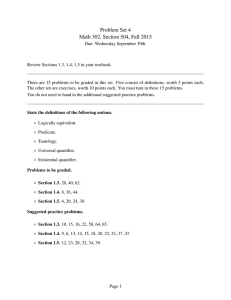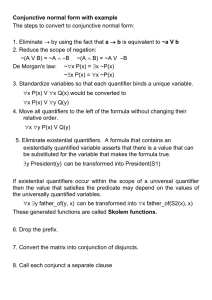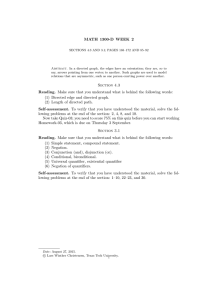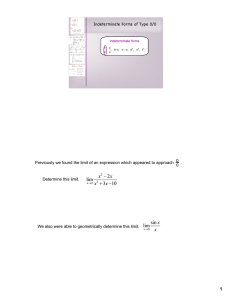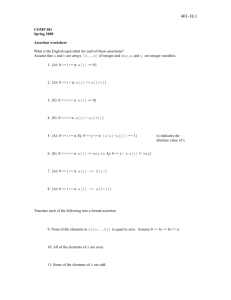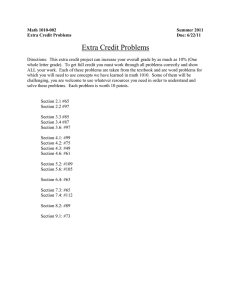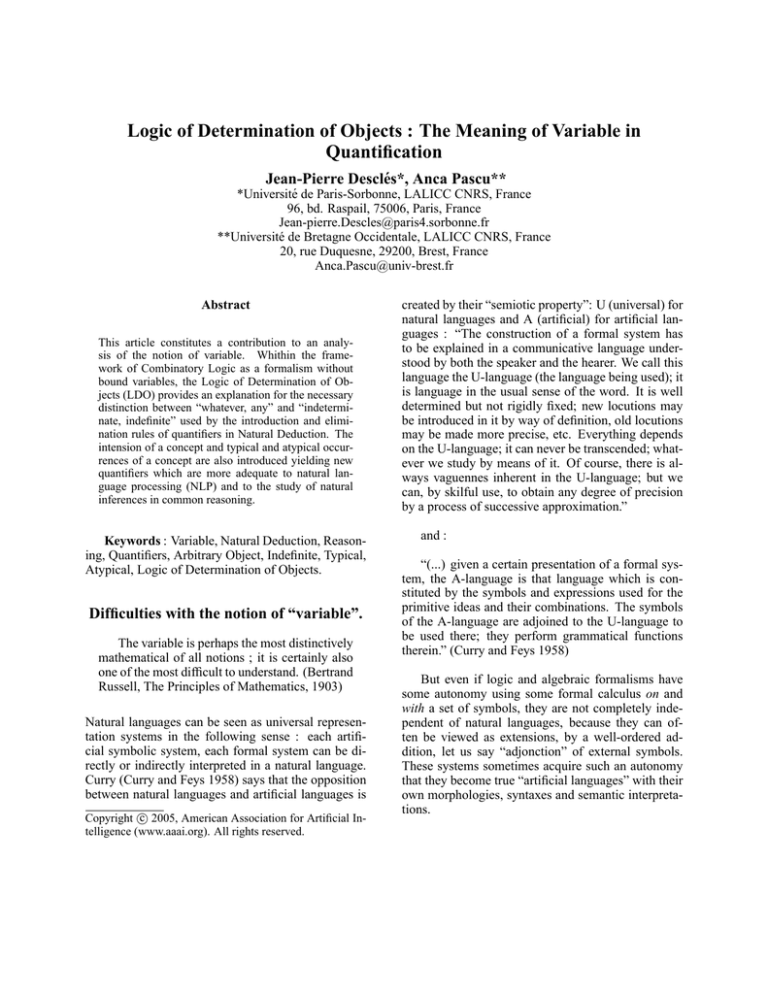
Logic of Determination of Objects : The Meaning of Variable in
Quantification
Jean-Pierre Desclés*, Anca Pascu**
*Université de Paris-Sorbonne, LALICC CNRS, France
96, bd. Raspail, 75006, Paris, France
Jean-pierre.Descles@paris4.sorbonne.fr
**Université de Bretagne Occidentale, LALICC CNRS, France
20, rue Duquesne, 29200, Brest, France
Anca.Pascu@univ-brest.fr
Abstract
This article constitutes a contribution to an analysis of the notion of variable. Whithin the framework of Combinatory Logic as a formalism without
bound variables, the Logic of Determination of Objects (LDO) provides an explanation for the necessary
distinction between “whatever, any” and “indeterminate, indefinite” used by the introduction and elimination rules of quantifiers in Natural Deduction. The
intension of a concept and typical and atypical occurrences of a concept are also introduced yielding new
quantifiers which are more adequate to natural language processing (NLP) and to the study of natural
inferences in common reasoning.
Keywords : Variable, Natural Deduction, Reasoning, Quantifiers, Arbitrary Object, Indefinite, Typical,
Atypical, Logic of Determination of Objects.
Difficulties with the notion of “variable”.
The variable is perhaps the most distinctively
mathematical of all notions ; it is certainly also
one of the most difficult to understand. (Bertrand
Russell, The Principles of Mathematics, 1903)
Natural languages can be seen as universal representation systems in the following sense : each artificial symbolic system, each formal system can be directly or indirectly interpreted in a natural language.
Curry (Curry and Feys 1958) says that the opposition
between natural languages and artificial languages is
c 2005, American Association for Artificial InCopyright telligence (www.aaai.org). All rights reserved.
created by their “semiotic property”: U (universal) for
natural languages and A (artificial) for artificial languages : “The construction of a formal system has
to be explained in a communicative language understood by both the speaker and the hearer. We call this
language the U-language (the language being used); it
is language in the usual sense of the word. It is well
determined but not rigidly fixed; new locutions may
be introduced in it by way of definition, old locutions
may be made more precise, etc. Everything depends
on the U-language; it can never be transcended; whatever we study by means of it. Of course, there is always vaguennes inherent in the U-language; but we
can, by skilful use, to obtain any degree of precision
by a process of successive approximation.”
and :
“(...) given a certain presentation of a formal system, the A-language is that language which is constituted by the symbols and expressions used for the
primitive ideas and their combinations. The symbols
of the A-language are adjoined to the U-language to
be used there; they perform grammatical functions
therein.” (Curry and Feys 1958)
But even if logic and algebraic formalisms have
some autonomy using some formal calculus on and
with a set of symbols, they are not completely independent of natural languages, because they can often be viewed as extensions, by a well-ordered addition, let us say “adjonction” of external symbols.
These systems sometimes acquire such an autonomy
that they become true “artificial languages” with their
own morphologies, syntaxes and semantic interpretations.
The notion of “variable” is used in almost all
fields, but with slightly different senses. This notion
comes from logic and mathematics. It was borrowed
by other fields, for example : computer sciences. In
computer sciences there are difficulties in using variables (Hudak 1989). So, functional programming languages without bound variables were defined to avoid
“side effects”.
In Curry’s combinatory logic (Curry and Feys
1958) the bound variable is not necessary. In this
formalism it is possible to define complex concepts
from more elementary concepts and also to develop
the illative logic with quantifiers without using bound
variables.
Ambiguity of “variable” in Natural
Deduction
It will be shown that, in the presentation of classical logic in Natural Deduction given by Gentzen
(Gentzen 1955), there is a crucial distinction between
the two meanings of the variable.
If logic is thout of as a codification of reasoning, then it should stay close to the practice of inference making, instead of being based on the notion of
truth. Natural Deduction explores the non-semantic
approach, by setting up a system for deriving conclusions from premises. Although this approach is of a
formal nature, it is advisable to keep some interpretation in mind. It introduces rules, separated into introduction rules and elimination rules, which are used to
derive new steps from hypotheses and already proved
steps in a deduction. According to Gentzen (Gentzen
1955), the rules are associated with every propositional connective, negation and quantifier, to express
an intuitive meaning of them. We follow the presentation given by Fitch (Fitch 1974) for introduction and
elimination rules quantifiers below :
Universal quantifier :
y
..
.
P (y)
(∀x) P (x)
[ i - ∀ ] (1)
(∀x)P (x)
..
.
P (y)
[ e -∀ ] (2)
It is necessary that y to be free for x.
The notion of free variable is explained as : In a
general, we will say that y is free for x in P , if after
writing y instead of x, no occurence which should be
free becomes bound.
Existential quantifier :
P (y)
..
.
..
.
(∃x) P (x)
[ i - ∃ ] (3)
(∃x) P (x)
y
P (y)
..
.
B
[ e - ∃ ] (4)
B
The following condition is required: x is not free
in B and in any hypothesis of a subderivation of B,
other than P (x).
It should be noted that the interpretation of the
variable in these rules is not the same. The crucial
difference is between the meaning of “any, whatever
” and the meaning of “indefinite, indeterminate”.
Following Van Dalen (Van Dalen 1991), the sense
of the introduction rule of the universal quantifier is :
If an arbitrary object x has the property P , then every
object has the property P .
Van Dalen explains the notion of “arbitrary object” as follows: The problem is that none of the objects we know in mathematics can be considered “arbitrary”. So instead of looking for the “arbitrary object” in the real word (as far as mathematics is concerned), let us try to find a syntactic criterion. Con-
sider a variable x (or a constant) in a derivation, are
there reasonable grounds for calling x “arbitrary”?
Here is a plausible suggestion: in the context of the
derivation we shall call x arbitrary if nothing has been
assumed concerning x. In more technical terms, x is
arbitrary at its particular occurence in a derivation if
the part of the derivation above it contains no hypotheses containing x free.
Desclés (Desclés and Cheong 2004) gives the introduction rule of the universal quantifier the following interpretation : .... It means that we carry out our
reasoning with “any element” / “whatever” denoted
by y (rule (1)). One has no hypothesis on y, one can
not reiterate an expression containing free occurences
of y in the sub-deduction following y introduction as
hypothesis. If this is the case, then the element denoted by y will be not “any” / “whatever” anymore
because of the fact that it has a property (for exemple B(y)). Let us suppose now that carrying out our
reasoning with this “any object”, one obtains that it
has the property P . Then we can state (∀x) P (x) that
is we can release the choice of y by introducing the
universal quantifier.
In the case of the introduction of the universal
quantifier the reasoning is founded on the notion of
“whatever”. In the elimination of the existential quantifier the reasoning runs with the variable interpreted
as an “indeterminate (undefined , non-specified)” object. Indeed, in this reasoning we suppose the existence of an object with the property P. The exact denotation of this object is not known. An “indeterminate”
object called y is introduced, and inferences about this
object are obtained. If the sequence of inferences concludes to a proposition B, then it can be concluded that
B follows from the hypothesis (∃ x) P(x).
In the two rules (universal quantifier introduction
and existential quantifier elimination) the formalism
use the same symbol (a variable y in the rules (1), (4))
but its meaning and its behavior is not the same.
“Whatever” and “indeterminate” in LDO
How can the two notions of “whatever” or “arbitrary
object ” (see Fine 1985) and “indeterminate” or “nonspecified” be distinguished?
In our opinion, LDO (Logic of Determination of
Object) provides a solution to this question. LDO
is defined inside the framework of combinatory logic
with functional types (Desclés 2002, Pascu 2001, Freund and alii 2004). In this approach a concept (see
Frege 1893) is a function from a domain of objects
into truth values. With every concept f the following
are canonically associated :
• an object called “typical object”, τ (f ) which represents the concept f as an object . This object is
completely undetermined;
• a function, δ(f ) defined on objects : the imageobject is more determined than the argument-object
for this function;
• the intesion of the concept, Int(f ) conceived as the
class of all concepts that the concept f “includes”,
that is a semantic network of concepts structured by
the relation “IS-A”;
• the expanse of the concept, Exp(f ) which contains
all “more or less determined objects” such that the
concept f applies to;
• a part of the expanse is the extension of the concept,
Ext (f ) which contains all completely determined
objects such that the concept f applies to.
In LDO objects are :“more or less determined objects” and “completely determined objects”. LDO
captures two kinds of objects : typical objects and
atypical objects. Typical objects in Exp(f ) inherit all
concepts of Int f ; atypical objects in Exp(f ) inherit
only some concepts of Int(f ).
In LDO star quantifiers are defined (Desclés and
Guentcheva 2001, Pascu 2001). They are considered
as determiners of objects in Exp(f ). These determiners are Π? et Σ? . They are different to the usual
quantifiers Π and Σ from the illative version (Curry
1958) of Frege’s quantifiers (Frege 1879) in combinatory logic. Indeed, in LDO, Π? is the universal
quantifier retricted to typical objects and Σ (Frege’s
existential quantifier) is the existential quantifier, but
also restricted to typical objects. Π and Σ? are respectively, the universal quantifier and the existential
quantifier not restricted to typical objects, that is, they
work on Ext(f ).
In LDO the object Π? (τ (f )) starting from τ (f ) is
constructed by applying the Π? operator (figure 1).
τ (f )
τ (f )
@
@
@
@
@
@
?
@
?
Π (τ (f ))
@
PP
PP @
R
P
)
q@
P
{a1
a2
... ...
...
an }
Ext(Π? (τ (f )))
Typical instances of f
Σ?
Π?
@
?
?
Σ (τ (f ))
@
@
@
@
I
@
@
R
@
@
{a1
... ...
an }
a part of Ext(f )All (typical or not)
instances of f
Figure 1: The construction of the object
“whatever, any”
Figure 2: The construction of the “indeterminate object”
In figure 1, a1 , a2 ,...., an are completely determined objects, which can be substituted for the undetermined object Π? (τ (f )).
is the object corresponding to “y” in rule (4). Both
objects Π? (τ (f )) and Σ? (τ (f )) are “more or less determined objects” in the sense of the LDO : they belong to Exp(f ), they are not completely determined
objects. But Π? (τ (f )) is the “any object / whatever”
object, as for Σ? (τ (f )) it is the “indeterminate / nonspecified” object. (figure 3)
Π? (τ (f )) is an object of Exp(f ) – Ext(f ). It represents a “whatever typical object” to which f applies.
This object is not in Ext(f ) but it can be identified
with any typical object of Ext(f ). Π? (τ (f )) is introduced as a “whatever object”. In the rule of universal
quantifier introduction (1) it is the object corresponding to the variable “y”. In fact, this rule, says that : if
we can state, by the inference process, the proposition
P(Π? (τ (f ))), then we can state the universal quantifier introduction.
In LDO the object Σ? (τ (f )) is constructed starting from τ (f ) by applying the Σ? operator (figure 2).
In figure 2 : a1 , a2 ,...., an are completely determined objects, such that :
f (a1 ) = f (a2 ) = . . . f (an ) = >
non-specified object,
abstract from a
any object,
abstract from a
Σ? (a)
Π? (a)
@
I
@
@
@
@
@
a
Moreover the following is an axiom :
?
f (Σ (τ (f )) = > ⇐⇒ Ext(f ) 6= ∅
Σ? (τ (f )) is also an object of Exp(f ) – Ext(f ). It
represents as an “undetermined object” a non-empty
part of Ext(f ). Σ? (τ (f )) is such that new propositions (like B) from the proposition P (Σ? (τ (f ))) that
is, by existential quantifier elimination. This object
object
Figure 3: “whatever / any” object versus “indeterminate / non-specified object”
Examples
Some examples from natural language are given to
prove that :
• Using classical logic in formalization of the language the typicality /atypicality cannot be captured;
• The indefinite article from a language with the variable from classical logic cannot be identified.
Let us consider the following examples :
1. An Alsatian drinks beer. (a typical Alsatian)
/Un alsacien boit de la bière.
In LDO, the statement :
(to−drink −beer)(Π∗ (τ (to−be−an−Alsatian)))
is true, but the folowing statements :
(∀x)(Alsatian x) ⊃ ((to − drink − beer) x)1
or equivalently,
3. A triangle has the sum of its angles equal to
180◦ . (whatever typical triangle) / Un triangle a la
somme de angles égale à 180◦ .
(S − 180)(Π∗ (τ T ))
where T stands for to − be − a − triangle and S-180
stands for to − have − the − sum − of − angles −
equal − to − 180.
3*. I found in the mathematical literature a triangle such that the sum of its angles is different from
180◦ . (it is not whatever, it is indeterminate, but it is
atypical versus the property “sum of angles equal to
180◦ ”) / J’ai trouvé dans la littérature mathématique
un triangle dont la somme des angles est différente de
180◦ .
(((to − f ind . . .)((δ (S − 180))(Σ∗ (τ T )))) I)
Π(to − be − Alsatian)(to − drink − beer)2 are
false.
4. A student pay his university fees. (an whatever
student and typical).3 /Un étudiant paie ses droits universitaires.
1*. Anca saw an Alsatian in the street. (an indeterminate Alsatian, one does not specify him) / Anca
a vu un alsacien dans la rue.
(P ay(Π∗ (τ (to − be − a − student))))
The applicative expression associated is :
(((SS)(Σ∗ (τ (to − be − an − Alsatian)))) Anca)
where SS stands for to − see − in − the − street.
2. A mathematician know how to solve this problem. (a typical mathematician) / Un mathématicien
sait résoudre ce problème.
(KSP )(Π∗ (τ (to − be − a − mathematician)))
where KSP stands for to − know − solving − this −
problem.
where Pay stands for to − pay − his − university −
f ees. One can see that from (P ay(Π∗ (τ (to − be −
a − student)))) we cannot deduce Σ(to − be −
student)(P ay)
The indefinite article in languages such as English
and French cannot be identified (as a notion) with the
variable of classical logic. We can see that the value
of the indefinite article “a, an” (“un, une” in French)
is either “whatever/any” object as in examples 1, 2,
3, 4, or “indeterminate/non-specified” object as in examples 1*, 2*, 2**, 3*.
2*. Luc is a strange mathematician. (not necessarily typical) / Luc est un mathématicien bizarre.
Conclusion
(((to−be)((δ (to−be−strange))(Σ∗ (τ M )))) Luc)
LDO extends classical logic since classical logic does
not take into account Intension or typical and atypical occurrences of a concept. In this latter case Expanse is reduced to Extension, even identical. Moreover, the distinction between “whatever” and “indeterminate, non-specified” is confused. This distinction is
essential in the study of natural deduction as a cognitive process, but also for Artificial Intelligence where
where M stands for to − be − a − mathematician
2**. Luc has a mathematician in his family. (not
necessarily typical) / Luc a un mathématicien dans sa
famille.
(((to − have − in − his − f amily)(Σ∗ (τ M )))Luc)
1
This is the logical form of this sentence in the classical
logic.
2
This is the form of this sentence in the Curry’s logic.
3
In France, in public universities all students have to pay
their university fees except the children of university teachers.
reasoning about typical or atypical occurrences leads
to solving local contradictions. LDO tries to explain
this distinction. More generally, LDO gives a logical
foundation to categorization and inference processes
with semantic networks. This distinction is very useful in capturing the meaning of indefinite articles and
linguistic quantifiers in natural languages.
References
Curry, H. B. and Feys, R. 1958. Combinatory Logic.
North Holland.
Desclés, J.-P. and Guentceva Z. 2001. Quantification Without Bound Variables. In Bőttner, Thümmel
(eds), Variable-free Semantic, 210–233. Osnabrück :
Secolo Verlag, Rolandsmauer 13-14.
Desclés, J.-P., 2002. Categorization : A Logical
Approach of a Cognitive Problem. In Journal of Cognitive Science 3(2): 85–137.
Desclés, J.-P. and Cheong, K.-S., 2004. Analyse critique de la notion de variable, Technical Report, LALICC, Sorbonne University. Forthcoming. In
Mathématiques et Sciences Humaines 74 pages.
Freund, M., Desclés, J.-P., Pascu, A. and Cardot,
J. Typicality, Contextual Inferences and Object Determination Logic. In Proceedings of the International
Florida Artificial Intelligence Research Society Conference, 491-495. Menlo Park, Calif.: AAAI Press.
Fine, K. 1985. Reasoning with Arbitrary Objects
Aristotelian Society Series, vol 3, Oxford :Blackwell.
Fitch, F. 1974. Elements of Combinatory Logic.
Yale University Press.
Frege, G. 1879. Begriffsschrift. Eine Formelsprache des reinen Denkens . Halle.
Frege, G. 1893. The Basic Laws of Arithmetic
(translated and edited with an introduction by Montgomery Furth in 1967. University of California Press.
Gentzen, G.1955. Untersuchungen über das logische Schließen - Recherches sur la déduction logique
(translated in French by Feys R. and Ladriere J. Paris
: Presses Universitaires de France.
Hudak, P. 1989. Conception, Evolution, and Application of Functional Programming Languages. In
ACM Computing Surveys 21:360–411.
Pascu, A. 2001. Logique de Détermination
d’Objets: concepts de base et mathématisation en vue
d’une modélisation objet. PhD diss., Département de
Logique, Informatique et Cognition (LALICC), Université de Paris-Sorbonne.
Russell, B. 1903. Principles of Mathematics. London, 1956. George Allen.
Van Dalen, D. 1994.
Springer-Verlag.
Logic and Structure.

